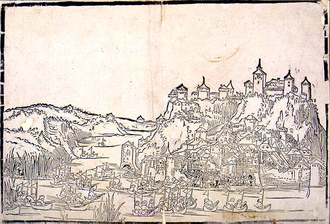Greek Weißenburg
Greek Weißenburg with the scholarly form Alba Graeca or Alba Bulgarica (in Byzantine sources Βελιγράδον , Veligradon , in Hungarian Nándorfehérvár ) was the common name for the Serbian capital Belgrade in the Middle Ages from the 9th to the 16th century. The previous Roman - Byzantine city of Singidunum disappeared with the Great Slav invasion around 630. The existence of a subsequent settlement was only reported 250 years later. The Slavic name Beligrad appeared as early as the 9th century, but only became more widespread in Europe in the course of the Turkish wars in the 17th century and gradually replaced the font name Greek-Weissenburg , which was used until the 19th century has been.
Naming convention
In the era of the Macedonians and Comnenes from the ninth to the twelfth centuries - in Europe this corresponds to the early and high Middle Ages, which are uncommon terms in Byzantine historiography - and especially for the time of the Byzantine hegemonic power from Basil II to Manuel I and II the subsequent Hungarian rule until 1403 it is appropriate to speak historically of Greek Weissenburg. Only the naming of Belgrade as a residential city under Stefan Lazarević , which represented an essential turning point in its history through the subsequent increase in importance of the city, marked the semiotic change from Greek Weissenburg to Belgrade: The Byzantine Kastron became a medieval city. The old naturalized name lasted until after the Turkish conquest in 1521. The term clearly identifies the four hundred year Byzantine history of Belgrade, which ends with the disappearance of Singidunum and the development of the medieval city at the beginning of the 15th century.
history

Belgrade was first mentioned in the ninth century as part of the First Bulgarian Empire , which under Simeon fought with Byzantium for supremacy in the Balkans. Tsar Simeon was able to briefly incorporate Belgrade into his empire, but with Johannes Tzimiskes (969–976), who pushed back the Russians and Bulgarians and made the Croats and Serbs vassals, the Byzantine expansion to the Danube and Sava began , which in the medium term could no longer be stopped was. In 976, after the death of Tzimikes, Belgrade fell again to the Greater Bulgarian Empire. The ensuing hegemonic conflict led to the protracted Bulgarian-Byzantine War (991-1014), which was decided by Basil II in 1014 in the battle of Kleidion in favor of Byzantium, whereby the kingdom of Samuil in 1018 was finally dissolved. This ended the leadership of the South Slavic peoples under Samuil, who was able to extend his empire from the Black Sea to the Adriatic, and the Balkan Peninsula was completely under Byzantine control, which was completed with the recognition of the Byzantine supremacy by the Croats and Serbs .
In the time of the Macedonians and Komnen, the Greek Weissenburg was a Byzantine castron that was integrated into the theme management. It was part of the Sirmium theme established by Basil II in 1018 . The city became an integral part of the Byzantine imperial borders for almost two centuries, but was regularly besieged and plundered by the Hungarians (1096, 1112 and 1127), who completely removed the fortification in 1112 and instead built the Zemun opposite .
Emperor Manuel I , who further underpinned Byzantine supremacy in the 12th century, was in Belgrade on several occasions and destroyed the Hungarian Zemun (Zeugminon) in 1165. At the same time he strengthened the fortification position in Belgrade in the form of a deltoid fort, which was approximately 135 m × 60 m in size, and with the decision in the Battle of Sirmium, he strengthened the northern borders of the Byzantine Empire against the Hungarians.
With the beginning of the decline of the Byzantine supremacy and after Jerusalem fell into the hands of the Seljuks in 1076 , the first crusades led through the city, which fell to Hungary in 1184. In 1189 Emperor Friedrich Barbarossa stayed with around 100,000 crusaders in the destroyed city, which played a rather subordinate role in the following 200 years. It was only under Stefan Lazarević that it gained importance as a residence that it had never had before and came into the focus of the Ottoman Empire , which fought fiercely for the city with the Hungarians (1444, 1456 and 1521 ).
Individual evidence
- ↑ Explanation of the Latin name (online resource)
- ↑ Paul Stephenson: Byzantium's Balkan frontier: a political study of the Northern Balkans, 900-1204 . Cambridge University Press, 2008 ( online; PDF; 2.2 MB ).
Coordinates: 44 ° 49 ′ 25 ″ N , 20 ° 27 ′ 1 ″ E

